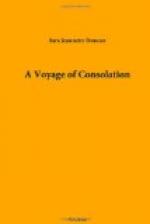“Isn’t it pretty strong?” asked poppa.
[Illustration: We followed the monks.]
“The influenza is stronger,” replied Mrs. Portheris oracularly, and finished her second potation.
“And nothing,” said Brother Eusebius sadly, “for the gentleman standing outside the door, who doesn’t approve of encouraging the Roman Catholic Church in any respect whatever. Dear me! dear me! we do get some queer customers.” At which Mr. Mafferton frowned portentously. But nothing seemed to have any effect on Brother Eusebius.
“There are such a lot of you, and you are sure to be so inquisitive, that we’ll both go with you,” said he, and took candles from a shelf. Not ordinary candles at all—coils of long, slender strips, with one end turned up to burn. At the sight of them momma shuddered and said she hadn’t thought it would be dark, and took the Senator’s arm as a precautionary measure. Then we followed the monks Eusebius and Demetrius, who wrapped shawls round their sloping shoulders and hurried across the grass towards the little brick entrance to the Catacombs, shading their candles from the wind that twisted their brown gowns round their legs, with all the anxiety to get it over shown by janitors of buildings of this world.
CHAPTER XIV.
At first through the square chambers of the early Popes and the narrow passages lined with empty cells, nearest to the world outside, we kept together, and it was mainly Eusebius who discoursed of the building of the Catacombs, which he informed us had a pagan beginning.
“But our blessed early bishops said, ’Why should the devil have all the accommodations?’ and when once the Church got its foot in there wasn’t much room for him. But a few pagans there are here to this day in better company than they ever kept above ground,” remarked Brother Eusebius.
“Can you tell them apart?” asked Mr. Dod, “the Christians and the Pagans?”
“Yes,” replied that holy man, “by the measurements of the jaw-bone. The Christians, you see, were always lecturing the other fellows, so their jaw-bones grew to an awful size. Some of ’em are simply parliamentary.”
“Dat,” said Brother Demetrius anxiously—as nobody had laughed—“ith a joke.”
“I noticed the intention,” said poppa. “It’s down in the guide-book that you’ve been ’absolved from the vow of silence’—is that correct?”
“Right you are,” said Brother Eusebius. “What about it?”
“Oh, nothing—only it explains a good deal. I guess you enjoy it, don’t you?”
But Brother Eusebius was bending over a cell in better preservation than most of them, and was illuminating with his candle the bones of the dweller in it. The light flickered on the skull of the Early Christian and the tonsure of the modern one and made comparisons. It also cut the darkness into solid blocks, and showed us broken bits of marble, faint stains of old frescoes, strange rough letters, and where it wavered furthest the uncertain lines of a graven cross.




